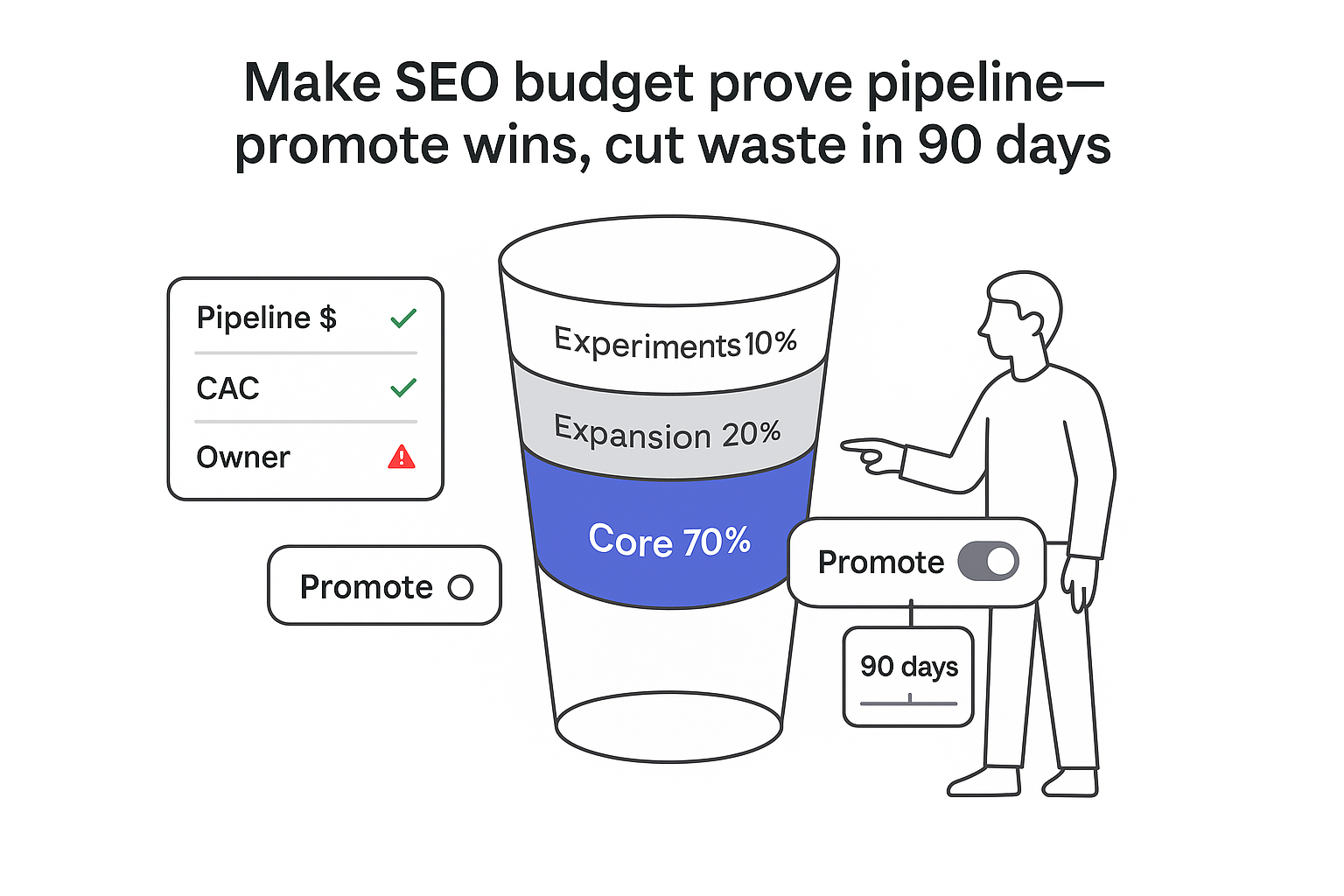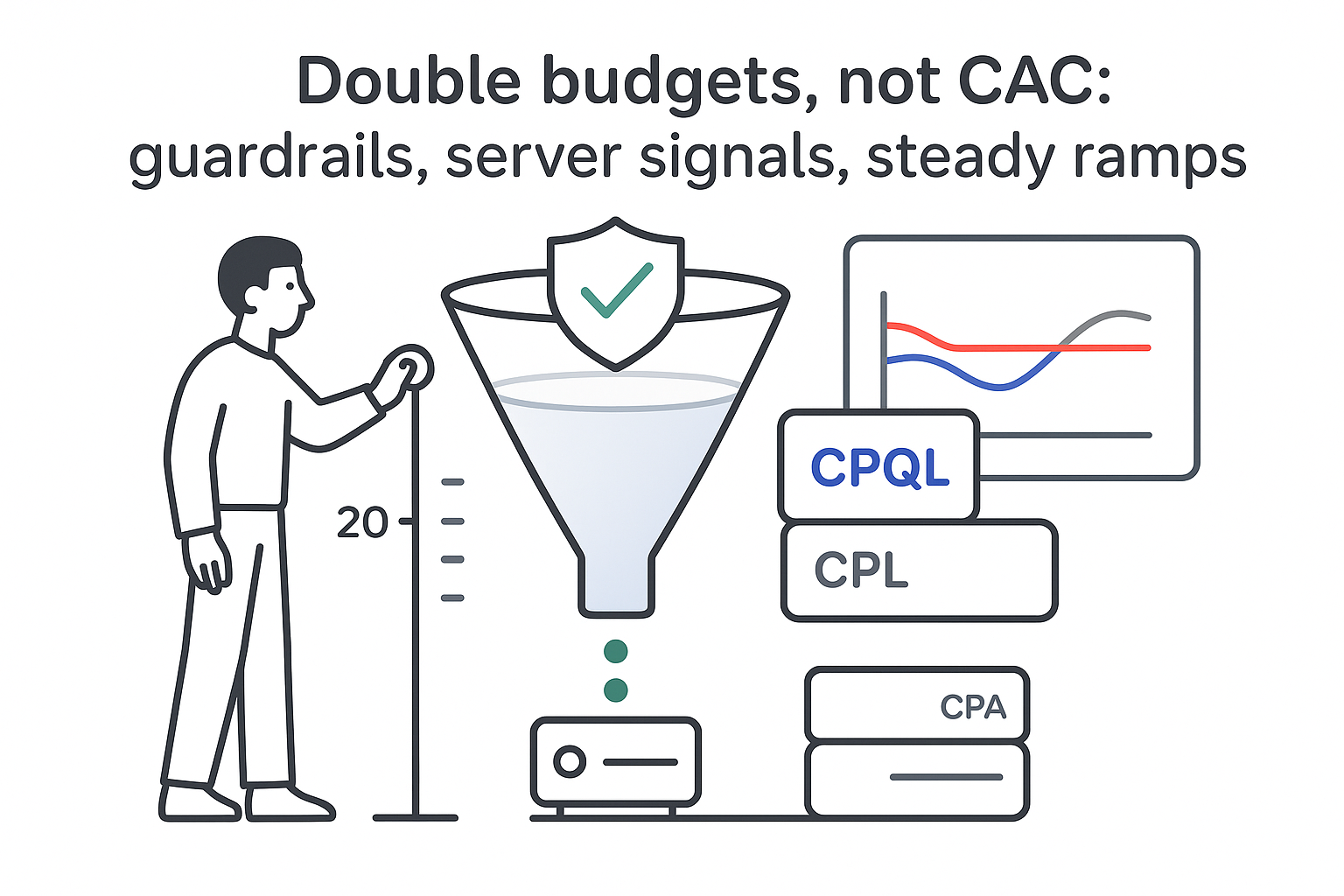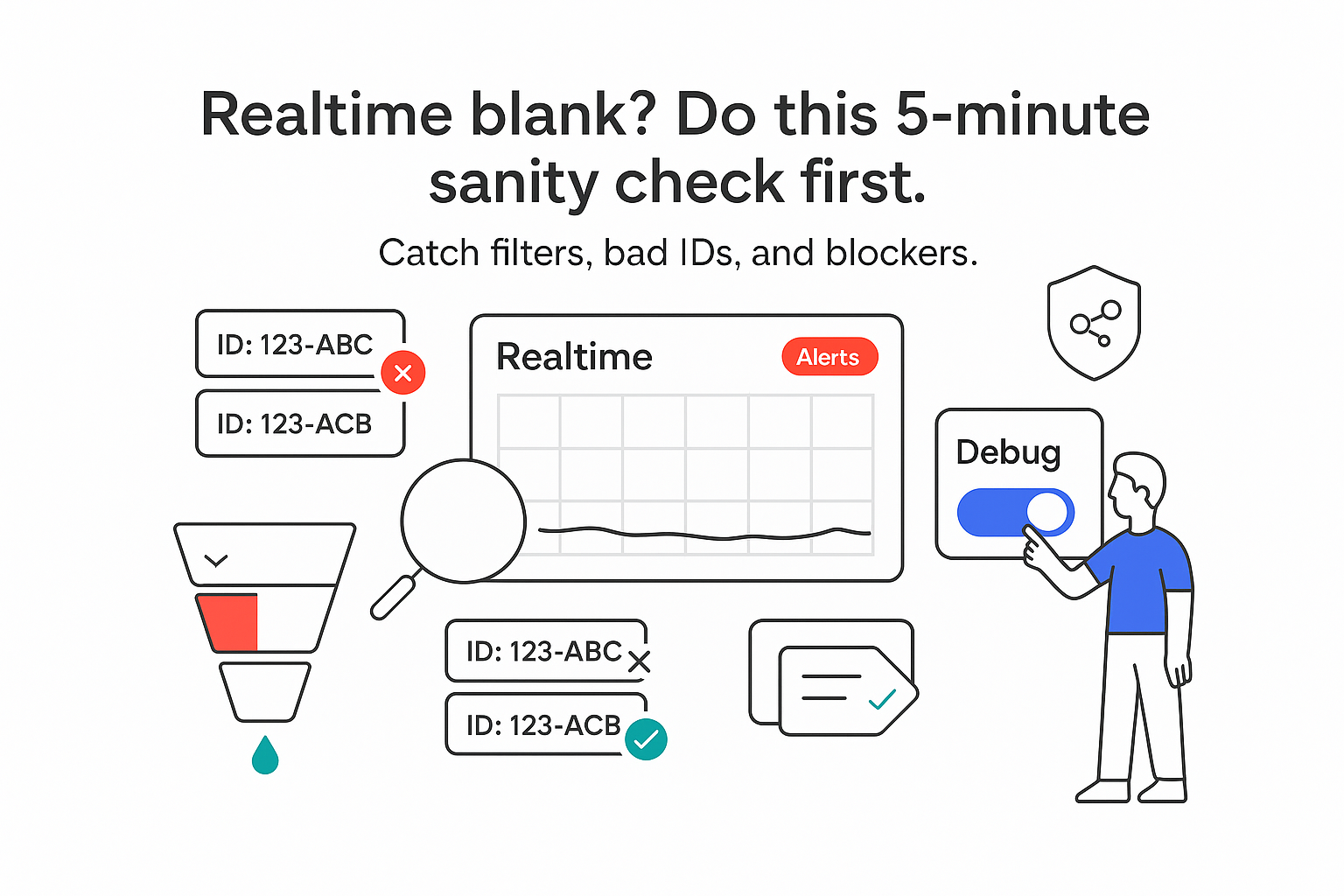I want predictable growth without babysitting vendors or pouring more cash into ads. I also want room for smart bets and a few bold tests that could move the needle. That mix is exactly why I use a simple split for SEO budgets: it takes the pressure off guesswork, assigns clear owners, and keeps everyone honest with KPIs tied to pipeline and CAC.
Here is one concrete split for a B2B service company spending 20,000 dollars per month on organic growth:
- 14,000 dollars to core work that compounds and feeds pipeline
- 4,000 dollars to expansion plays with measurable upside
- 2,000 dollars to experiments that might look small now but can open new doors
One-line definition: 70-20-10 SEO budgeting balances predictability, growth, and innovation so I can compound what works, add new reach, and keep testing smarter paths.
Decision-maker outcomes by slice
- 70 percent fuels qualified pipeline by growing non-brand traffic, ranking content hubs, and improving conversion paths
- 20 percent creates new sales-qualified opportunities by claiming incremental SERPs my ICP actually searches
- 10 percent protects CAC over time by finding low-cost wins in features, formats, and workflows
Sample KPI stack per slice
- 70 percent: non-brand sessions, hub-and-spoke keyword rankings, Core Web Vitals and page speed, demo/lead form conversion rate
- 20 percent: incremental topic rankings, new ICP SERP coverage, top-20 visibility within 60 to 90 days where competition allows, assisted pipeline from new clusters
- 10 percent: test learnings captured, early impressions and click lift, SERP feature wins, new format adoption
Accountability matters. I assign one owner per slice and review the mix every quarter. I rebalance monthly if the data calls for it. Clear owners reduce noise and keep execution tight.
Why I use 70-20-10 for SEO budgeting
The model works because it separates compounding work from growth bets and controlled experiments. It mirrors the clean clarity many PPC managers use, adapted for SEO. I avoid the common trap of starving proven pages to fund shiny objects - or never testing at all - and I can explain the trade-offs to finance and sales in one slide.
The split also echoes well-known portfolio ideas like the ambition matrix and resource allocation practices popularized by leaders such as Eric Schmidt and Sergey Brin. If you want a practical PPC perspective on budget allocation, this webinar is a useful companion: How to Allocate Your Budget Wisely for 2019. For broader context - and critiques to keep you honest - see McKinsey & Company on the Three Horizons model and Steve Blank on its limitations.
The 70% core: the compounding engine
Most spend goes to work I can count on. This protects performance and pushes steady gains with low variance.
What lives here
- Technical SEO remediation and monitoring
- Content hubs and ongoing refreshes of top performers
- Internal linking and crawl budget care
- UX tweaks that remove friction and lift conversion
- Digital PR that builds authority at sane costs
Suggested sub-split inside the 70 percent
- 30 percent content production and refreshes
- 20 percent technical fixes and platform health
- 20 percent authority and digital PR
- 30 percent UX/CRO and internal linking
Timelines I can bank on
(Competition and domain strength affect pace.)
- 60 to 120 days to see traction from technical fixes and refreshes
- 90 to 180 days for new hubs to mature, faster when domain authority and internal links are strong
A simple plan snapshot
- Refresh top 10 revenue pages - 4,000 dollars/month - target +20% non-brand clicks by day 90
- Technical backlog sprints - 3,000 dollars/month - target 95% Core Web Vitals pass on key templates by day 60
- New hub on a priority ICP pain - 4,000 dollars/month - target top-10 for 8 target terms by day 150
- Digital PR cadence - 3,000 dollars/month - target 4 high-quality mentions per month
Mindset: paid teams keep evergreen campaigns fully funded because they drive conversions. Same idea here - just SEO flavored.
The 20% expansion: measurable upside with medium risk
This slice funds expansion plays with clear upside. Risk is medium, reward is also medium, and the feedback loop is often faster than it looks.
What I test here
- New ICP or topic clusters with real search demand
- Programmatic pilots that publish useful pages under tight quality rules
- High-intent pages sales keeps asking for (comparison, alternatives, pricing)
- International or industry subfolders when there is clear fit and operational support
Acceptance criteria before I greenlight
- Market size: at least a few thousand monthly searches across the cluster
- Difficulty: targets where my domain can land top 10 with solid content and links
- ICP fit: mirrors what best-fit customers say on calls and in emails
- Content ops: bandwidth exists to maintain and refresh, not just publish once
Success thresholds I use
- Top-20 placements for head and mid-tail in 60 to 90 days where feasible
- Assisted pipeline visible in CRM within the quarter
- If impressions are not climbing by week 4 to 6, I adjust or pause
The mental picture: a pipeline funnel next to a list of new SERPs. As coverage rises, more of the right buyers land on my pages. That is the point of this slice.
The 10% experiments: smart, gated bets
This is lab time. It is small by design, and it still needs rules.
Good experiments
- SERP feature optimization (e.g., FAQ and HowTo where they still show)
- AI-assisted content with human QA and strong sources
- Video-to-SEO repurposing (transcripts, chapters, how-to articles)
- Schema-led wins (Product, Review, Organization) where it makes sense
- New link acquisition angles (data pulls, unique research, or formats)
Kill-or-scale rules I follow
- Run for 1 to 2 sprints
- Keep a risk ceiling such as 10 percent of pages or 10 percent of crawl budget
- Scale only when I see rising impressions, feature captures, or first-click wins
- Shut it down fast when there is noise or zero lift, then record the lesson
Learning capture template
- Hypothesis, setup notes, URLs touched
- Before-and-after metrics from Search Console
- What worked, what failed, what I am testing next
This slice buys optionality. I do not bet the quarter on it, but the wins I keep can reshape the plan for the next quarter.
Cadence, governance, and getting started
A simple operating cadence keeps the model steady.
Cadence
- Quarterly plan that sets the 70, the 20, and the 10 with budgets, owners, and targets
- Monthly rebalancing based on search trends, pipeline needs, and fresh results
- Weekly standups to unblock tasks and keep delivery moving
Governance
- OKRs tied to pipeline targets, not vanity traffic
- One owner per slice with a clear RACI
- A single-page plan listing initiatives, spend, KPIs, and review dates
Portfolio rules
- If a 10 percent test proves out twice, promote it to the 20 percent slice
- If a 20 percent play wins for two quarters with repeatable ROI, promote it to the 70 percent slice
- If anything in the 70 percent group underperforms for a full quarter, fix or demote it
A fast start I can run in 90 days
- Audit crawl health and size demand by ICP; pair findings with sales-call notes and win-loss insights
- Set quarterly pipeline-from-organic and SQO targets with finance and sales
- Confirm the 70-20-10 split, owners, and must-do fixes in the 70 percent list
- Prioritize initiatives with a simple impact/effort/risk model (traffic gain × expected CVR × revenue per lead)
- Stand up dashboards that blend GA4, Search Console, and CRM so attribution to pipeline is visible
- Plan two-week sprints for content, technical, and PR; lock a pre-approved backlog for two sprints
- Review monthly; shift funds toward what is working; retire what is not
I keep one lighthouse page: three columns (70/20/10), each with named owners, initiatives, spend, KPIs, and dates.
Benefits, proof metrics, and a brief example
This model addresses common CEO pains without fluff.
Benefits
- Predictable growth from the 70 percent slice: I protect core rankings, keep speed high, and refresh winners. That steadies qualified demand.
- Near-term wins from the 20 percent slice: fresh clusters and intent pages earn new SERP coverage and help sales with better-fit leads.
- Future-proofing from the 10 percent slice: small bets keep CAC in check as the market shifts.
Cost efficiency compared to paid media
- Over 6 to 12 months, a funded 70 percent slice adds compounding traffic and raises conversion rate on owned pages. Blended CAC trends down even if CPCs rise.
- The 20 percent slice finds new terms where paid would be costly. These terms pay back long after the first click.
- The 10 percent slice surfaces features and formats that drop content costs next quarter.
Proof-style metrics I track
- Pipeline influenced by organic, by segment and by intent
- SQO rate from organic vs other channels
- CAC payback from organic-sourced deals
- Time to first meeting after an organic touch
A practical example (ranges vary by market and baseline)
- Starting point: 400 SQOs per quarter, ~30 percent from organic, CAC at 2,500 dollars, budget at 20,000 dollars/month
- After two quarters with this model: organic SQOs up ~30 percent; total SQOs at 460 to 520 depending on season; CAC flat to down ~10 percent from higher conversion on refreshed hubs
- Why it holds: the 70 percent slice cuts waste and boosts non-brand traffic that converts; the 20 percent slice grabs comparison and pricing terms that speed up sales; the 10 percent slice finds light-lift features that add clicks at low cost
For additional background on portfolio thinking and why balanced allocations tend to outperform, see this HBR study.
Pitfalls and choosing the right ratio by maturity
A few snags can slow teams. None are fatal if I call them early.
Common pitfalls
- Wrong ratios: over-experimenting starves the core; never testing stalls growth. I use guardrails like 60-30-10 for early-stage or 80-15-5 for mature brands.
- Low actionability: no owners, fuzzy KPIs, scattered tasks. I assign named owners, keep one operating doc, and run weekly standups with decisions recorded.
- Organizational blockers: thin content bandwidth, long dev queues, slow legal review. I lock a pre-approved backlog for two sprints, reserve dev hours for SEO, and use templates that speed legal checks.
- Unmanaged risk: programmatic pages can bloat the site; AI can produce weak claims. I keep a risk ceiling, include human QA in the publishing gate, and roll back fast when quality dips.
Finding the right ratio by maturity
- Early-stage B2B: 60-30-10 for more reach and proof while funding the few pages that already work
- Growth stage: 70-20-10 for a solid base, steady expansion, and light experiments
- Enterprise: 80-15-5 for core reliability, a slimmer set of bets, and focused tests that clear brand and compliance
I keep a simple matrix in mind: company maturity on one axis, 70-20-10 ratios on the other. It keeps the conversation grounded.
Final thought I use in my next ops meeting
SEO is called slow too often. It is not slow when I run it like a portfolio, assign owners, and track pipeline. 70-20-10 SEO budgeting gives me that clarity. It protects the base, grows reach where it counts, and keeps a healthy streak of curiosity alive - and yes, it lets me sleep better at quarter end. If you want a deeper, plug-and-play way to stand this up, Get the toolkit.







.svg)